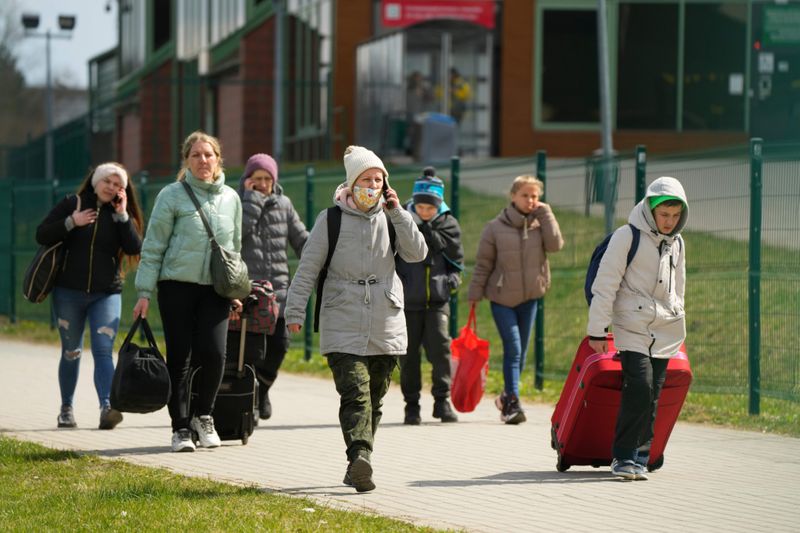
The UN Refugee Agency, United Nations High Commissioner for Refugees (UNHCR) annual Global Trends Report, shows that the number of people forced to flee their homes continues to rise globally. By the end of 2021, the number had gone up to 89.3 million, an 8 per cent increase from 2020.
The total number of forcibly displaced people has doubled in the last decade. Moreover, the Ukraine conflict this year, as per the UNHCR’s estimation, seems to have added another 13 million forcibly displaced people. Thus, by the end of May 2022, the wars, civil wars, ethnic conflicts, persecutions, human rights violence, and political instabilities have already forcibly displaced more than 100 million people worldwide.
More than half of these 100 million displaced people are internally displaced. Before the Ukraine War, there were 27.1 million refugees, 4.6 million asylum seekers, and 4.4 million Venezuelans displaced abroad. Two-thirds of the forced migrant population who have crossed their national border are from five countries only: Syria, Venezuela, Afghanistan, South Sudan, and Myanmar.
Most of these refugees don’t migrate to Europe or North America; they live in their neighbouring countries, fleeing from their own. Low- and middle-income countries host 83 per cent of the total refugee population. In 2021, only 429,300 refugees had returned to their home country. In the last two years, the number of refugee resettlement has reduced considerably, mainly due to Covid-19-related travel restrictions.

Conflict forces these people to move. Those who can, they cross their national border and those who are unable to do so move to another area within their country. In 2021, most of the increase in forced displacement took place in Afghanistan after the Taliban’s violent takeover of power, in Ethiopia due to war in Tigray, in the Central Sahel region due to violent insurgencies, and in Myanmar due to a military coup.
The ongoing war in Ukraine is responsible for this year’s massive increase in the number of refugees and internally displaced persons.
While internally displaced persons are more in number and live in a highly vulnerable situation, they rarely become the international community’s concern compared to the refugee issue. However, the global refugee population number within the UNHCR’s mandate has been showing some years of increase and then a period of decline since the 1980s. In 1981, there were 8.5 million refugees only.
With the end of the Cold War, the world went through a power shift, making it politically unstable for some years. The number of armed conflicts peaked in the early 1990s, and several new states were formed in the aftermath of the collapse of the Soviet Union and Yugoslavia. In 1990, the number of refugees thus jumped to 17.4 million.
After the initial chaos, the world started settling down, multilateralism gained strength, and the number of violent conflicts reduced considerably in the last decade of the 20th century and the first decade of the 21st century. In 2006, the refugee population came down to almost 1981 level, reaching 8.4 million. However, the so-called Arab Spring broke that trend. For more than a decade, the world started to witness not only an increasing number of conflicts but also conflicts becoming more deadly.
The effects of these conflicts continue to be devastating to the collective well-being of nations. Due to violent wars and civil wars, developing countries in Asia, Africa, Central America, and the Middle East are further submerged by the disruption to the formal economy, the destruction of physical infrastructure, and renewed tensions between social groups.

While many of these conflict-affected countries struggle to cope with the ongoing effects of wars and civil wars, others struggle to gain security and stability after formally ending the wars. The increasing number of new conflicts and the revival of the old ones have again surged the global refugee population. After the Ukraine War, the number of refugee population has crossed 33 million, four times more than what it used to be 16 years ago.
Not only does conflict force people to displace, but the movement of refugees also diffuses new conflicts. Sometimes, permitting the refugees to enter their territory may inflame the relationship between the transit state and the destination country, as the world has recently witnessed in Belarus.
In other cases, after being settled in the host country, refugee groups may engage themselves in anti-regime activities against their home-country government. Sometimes, refugees are also encouraged to do this by host countries because of existing political differences between the host and the home states. One can find several examples of this.
Unfortunately, the world has gone into a dangerous loop of refugee-conflict nexus. More conflicts are making more refugees, and the increasing number of refugees catalyses new conflicts. The growing refugee number has also become one of the primary reasons for the rise of far-right forces in Europe and North America, bringing severe challenges to established political norms and destroying the well-accepted societal consensus.
The UNHCR Global Trend report shows that it is high time that the international community must work overtime to prevent disputes in different parts of the world from escalating. That can only limit the number and intensity of the violent conflicts worldwide and, with it, bring down the number of the refugee population. But, who is listening?









